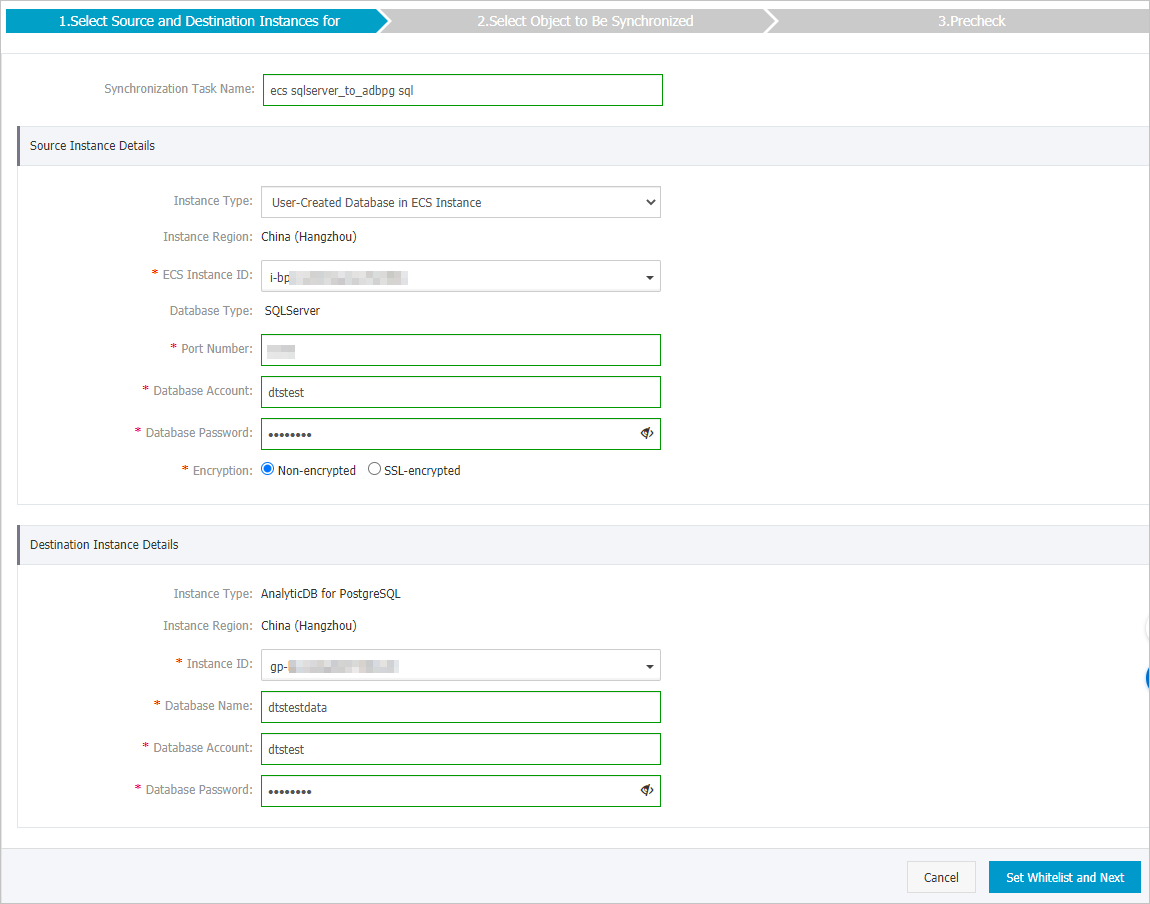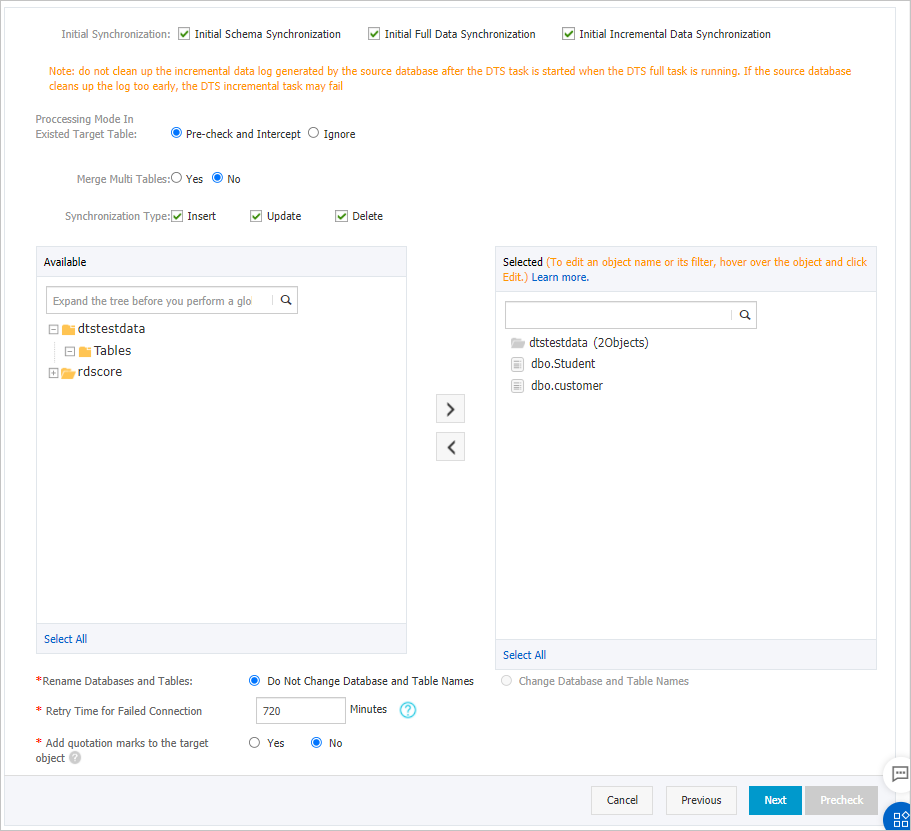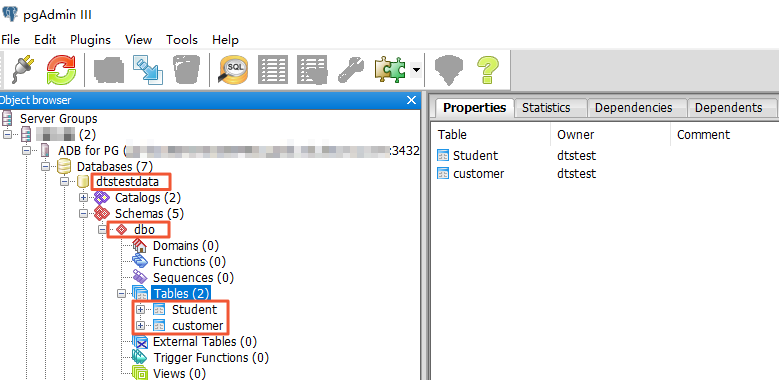This topic describes how to synchronize data from an ApsaraDB RDS for SQL Server instance to an AnalyticDB for PostgreSQL instance by using Data Transmission Service (DTS). The data synchronization feature allows you to transfer and analyze data with ease.
Prerequisites
An ApsaraDB RDS for SQL Server instance is created. For more information, see Create an ApsaraDB RDS for SQL Server instance and Overview of data synchronization scenarios.
ImportantThe engine version of the ApsaraDB RDS for SQL Server instance can be 2012, 2014, 2016, 2017, or 2019.
An AnalyticDB for PostgreSQL instance is created. For more information, see Create an AnalyticDB for PostgreSQL instance.
The source tables in the ApsaraDB RDS for SQL Server instance contain primary keys.
The destination tables in the AnalyticDB for PostgreSQL instance contain primary keys or unique indexes.
Usage notes
DTS uses read and write resources of the source and destination databases during full data migration. This may increase the loads of the database servers. If the database performance is unfavorable, the specification is low, or the data volume is large, database services may become unavailable. For example, DTS occupies a large amount of read and write resources in the following cases: a large number of slow SQL queries are performed on the source database, the tables have no primary keys, or a deadlock occurs in the destination database. Before you migrate data, evaluate the impact of data migration on the performance of the source and destination databases. We recommend that you migrate data during off-peak hours. For example, you can migrate data when the CPU utilization of the source and destination databases is less than 30%.
To ensure that the latency of data synchronization is accurate, DTS adds a heartbeat table to the source database. The name of the heartbeat table is
dts_log_heart_beat.In this scenario, DTS supports schema synchronization for the following types of objects: schema, table, view, function, and procedure.
WarningApsaraDB RDS for SQL Server and AnalyticDB for PostgreSQL are heterogeneous databases. The data types that they support do not have one-to-one correspondence. We recommend that you evaluate the impact of data type conversion on your business. For more information, see Data type mappings for schema synchronization.
DTS does not synchronize data of the following types: TIMESTAMP, CURSOR, ROWVERSION, HIERARCHYID, SQL_VARIANT, SPATIAL GEOMETRY, SPATIAL GEOGRAPHY, and TABLE.
Billing
| Synchronization type | Task configuration fee |
| Schema synchronization and full data synchronization | Free of charge. |
| Incremental data synchronization | Charged. For more information, see Billing overview. |
SQL operations that can be synchronized
DDL operation: ADD COLUMN
NoteDTS does not migrate transactional DDL operations.
DML operations: INSERT, UPDATE, and DELETE
Permissions required for database accounts
Database | Required permission | Authorization method |
ApsaraDB RDS for SQL Server instance | Permissions of the source database owner | |
AnalyticDB for PostgreSQL instance |
Note You can use the initial account of the AnalyticDB for PostgreSQL instance. |
Procedure
Purchase a data synchronization instance. For more information, see Purchase a DTS instance.
NoteOn the buy page, set the Source Instance parameter to SQL Server, the Destination Instance parameter to AnalyticDB for PostgreSQL, and the Synchronization Topology parameter to One-way Synchronization.
Log on to the DTS console.
In the left-side navigation pane, click Data Synchronization.
At the top of the Synchronization Tasks page, select the region where the destination instance resides.
Find the data synchronization instance and click Configure Synchronization Channel in the Actions column.
Configure the source and destination instances.

Section
Parameter
Description
N/A
Synchronization Task Name
The task name that DTS automatically generates. We recommend that you specify a descriptive name that makes it easy to identify the task. You do not need to use a unique task name.
Source Instance Details
Instance Type
The instance type of the source instance. Select RDS Instance.
Instance Region
The source region that you selected on the buy page. You cannot change the value of this parameter.
Instance ID
The ID of the source ApsaraDB RDS for SQL Server instance.
Database Account
The database account of the ApsaraDB RDS for SQL Server instance. For information about the permissions that are required for the account, see Permissions required for database accounts.
Database Password
The password of the database account.
Encryption
Specifies whether to encrypt the connection to the source instance. Select Non-encrypted or SSL-encrypted. If you want to select SSL-encrypted, you must enable SSL encryption for the ApsaraDB RDS for SQL Server instance before you configure the data synchronization task. For more information, see Configure the SSL encryption feature.
NoteThe Encryption parameter is available only for regions in the Chinese mainland and the China (Hong Kong) region.
Destination Instance Details
Instance Type
The value of this parameter is fixed to AnalyticDB for PostgreSQL.
Instance Region
The destination region that you selected on the buy page. You cannot change the value of this parameter.
Instance ID
The ID of the destination AnalyticDB for PostgreSQL instance.
Database Name
The name of the destination database.
Database Account
The database account of the destination AnalyticDB for PostgreSQL instance. For information about the permissions that are required for the account, see Permissions required for database accounts.
Database Password
The password of the database account.
In the lower-right corner of the page, click Set Whitelist and Next.
If the source or destination database is an Alibaba Cloud database instance, such as an ApsaraDB RDS for MySQL or ApsaraDB for MongoDB instance, DTS automatically adds the CIDR blocks of DTS servers to the IP address whitelist of the instance. If the source or destination database is a self-managed database hosted on an Elastic Compute Service (ECS) instance, DTS automatically adds the CIDR blocks of DTS servers to the security group rules of the ECS instance, and you must make sure that the ECS instance can access the database. If the self-managed database is hosted on multiple ECS instances, you must manually add the CIDR blocks of DTS servers to the security group rules of each ECS instance. If the source or destination database is a self-managed database that is deployed in a data center or provided by a third-party cloud service provider, you must manually add the CIDR blocks of DTS servers to the IP address whitelist of the database to allow DTS to access the database. For more information, see Add the CIDR blocks of DTS servers.
WarningIf the CIDR blocks of DTS servers are automatically or manually added to the whitelist of the database or instance, or to the ECS security group rules, security risks may arise. Therefore, before you use DTS to synchronize data, you must understand and acknowledge the potential risks and take preventive measures, including but not limited to the following measures: enhancing the security of your username and password, limiting the ports that are exposed, authenticating API calls, regularly checking the whitelist or ECS security group rules and forbidding unauthorized CIDR blocks, or connecting the database to DTS by using Express Connect, VPN Gateway, or Smart Access Gateway.
Select the synchronization policy and the objects to be synchronized.

Setting
Description
Initialize Synchronization
Initial Schema Synchronization, Initial Full Data Synchronization, and Initial Incremental Data Synchronization are selected by default. After the precheck is complete, DTS synchronizes the schemas and data of objects from the source instance to the destination instance. The schemas and data are the basis for subsequent incremental synchronization.
Processing Mode In Existed Target Table
Pre-check and Intercept: checks whether the destination database contains tables that have the same names as tables in the source database. If the destination database does not contain tables that have the same names as tables in the source database, the precheck is passed. Otherwise, an error is returned during precheck and the data synchronization task cannot be started.
NoteIf the source and destination databases contain identical table names and the tables in the destination database cannot be deleted or renamed, you can use the object name mapping feature to rename the tables that are synchronized to the destination database. For more information, see Rename an object to be synchronized.
Ignore Errors and Proceed: skips the precheck for identical table names in the source and destination databases.
WarningIf you select Ignore Errors and Proceed, data inconsistency may occur and your business may be exposed to potential risks.
If the source and destination databases have the same schema, DTS does not synchronize data records that have the same primary keys as data records in the destination database.
If the source and destination databases have different schemas, initial data synchronization may fail. In this case, only part of columns are synchronized, or the data synchronization task fails.
Merge Multi Tables
Yes: In online transaction processing (OLTP) scenarios, sharding is implemented to speed up the response to business tables. However, AnalyticDB for PostgreSQL allows you to store a large amount of data in a single table and makes your SQL queries more efficient. You can merge multiple source tables that have the same schema into a single destination table. This feature allows you to synchronize data from multiple tables in the source database to a single table in AnalyticDB for PostgreSQL.
NoteAfter you select multiple tables from the source database, you must change the names of these tables to the name of the destination table in AnalyticDB for PostgreSQL. To do this, you can use the object name mapping feature. For more information about how to use this feature, see Rename an object to be synchronized.
You must add a column named
__dts_data_sourceto the destination table in AnalyticDB for PostgreSQL. This column is used to record the data source. The data type of this column is TEXT. DTS writes column values in the following format:<Data synchronization instance ID>:<Source database name>.<Source schema name>.<Source table name>. Such column values allow DTS to identify each source table. For example,dts********:dtstestdata.testschema.customer1indicates that the source table is customer1.If you set this parameter to Yes, all the selected source tables in the task are merged into a destination table. If you do not need to merge specific source tables, you can create a separate data synchronization task for these tables.
No: the default value.
Select the operation types
Select the types of operations that you want to synchronize based on your business requirements. All operation types are selected by default.
Select the objects to be synchronized
Select one or more objects from the Available section and click the
 icon to add the objects to the Selected section.
icon to add the objects to the Selected section. In this scenario, data synchronization is performed between heterogeneous databases. Therefore, the objects to synchronize are tables, and other objects such as views, triggers, and stored procedures are not synchronized to the destination database.
NoteBy default, after an object is synchronized to the destination instance, the name of the object remains unchanged. You can use the object name mapping feature to rename the objects that are synchronized to the destination instance. For more information, see Rename an object to be synchronized.
If you set the Merge Multi Tables parameter to Yes, you must change the names of the selected tables to the name of the destination table in the AnalyticDB for PostgreSQL instance. To do this, you can use the object name mapping feature.
Add quotation marks to the target object
Specify whether you need to enclose object names in quotation marks. If you select Yes and the following conditions are met, DTS encloses object names in single quotation marks (') or double quotation marks (") during schema synchronization and incremental data synchronization.
The business environment of the source database is case-sensitive, and the database name contains both uppercase and lowercase letters.
A source table name does not start with a letter and contains characters other than letters, digits, and special characters.
NoteA source table name can contain only the following special characters: underscores (_), number signs (#), and dollar signs ($).
The names of the schemas, tables, or columns that you want to synchronize are keywords, reserved keywords, or invalid characters in the destination database.
NoteIf you select Yes, after DTS synchronizes data to the destination database, you must specify the object name in quotation marks to query the object.
Rename Databases and Tables
You can use the object name mapping feature to rename the objects that are synchronized to the destination instance. For more information, see Object name mapping.
Retry Time for Failed Connections
By default, if DTS fails to connect to the source or destination database, DTS retries within the next 720 minutes (12 hours). You can specify the retry time based on your needs. If DTS reconnects to the source and destination databases within the specified time, DTS resumes the data synchronization task. Otherwise, the data synchronization task fails.
NoteWhen DTS retries a connection, you are charged for the DTS instance. We recommend that you specify the retry time based on your business needs. You can also release the DTS instance at your earliest opportunity after the source and destination instances are released.
Specify the table type, primary key column, and distribution key of the tables that you want to synchronize to the AnalyticDB for PostgreSQL instance.
 Note
NoteFor more information about primary key columns and distribution columns, see Manage tables and Define table distribution.
In the lower-right corner of the page, click Precheck.
NoteBefore you can start the data synchronization task, DTS performs a precheck. You can start the data synchronization task only after the task passes the precheck.
If the task fails to pass the precheck, you can click the
 icon next to each failed item to view details.
icon next to each failed item to view details. After you troubleshoot the issues based on the details, initiate a new precheck.
If you do not need to troubleshoot the issues, ignore the failed items and initiate a new precheck.
Close the Precheck dialog box after the following message is displayed: The precheck is passed. Then, the data synchronization task starts.
Wait until the initial synchronization is complete and the data synchronization task is in the Synchronizing state.
You can view the status of the data synchronization task on the Synchronization Tasks page.

FAQ
Q: How do I find the tables that are synchronized to the AnalyticDB for PostgreSQL instance?
A: During schema synchronization, DTS synchronizes tables to the destination database based on the schema of the source database. In this example, you can find the customer and Student tables in the dbo schema of the dtstestdata database in the destination instance, as shown in the following figure. 